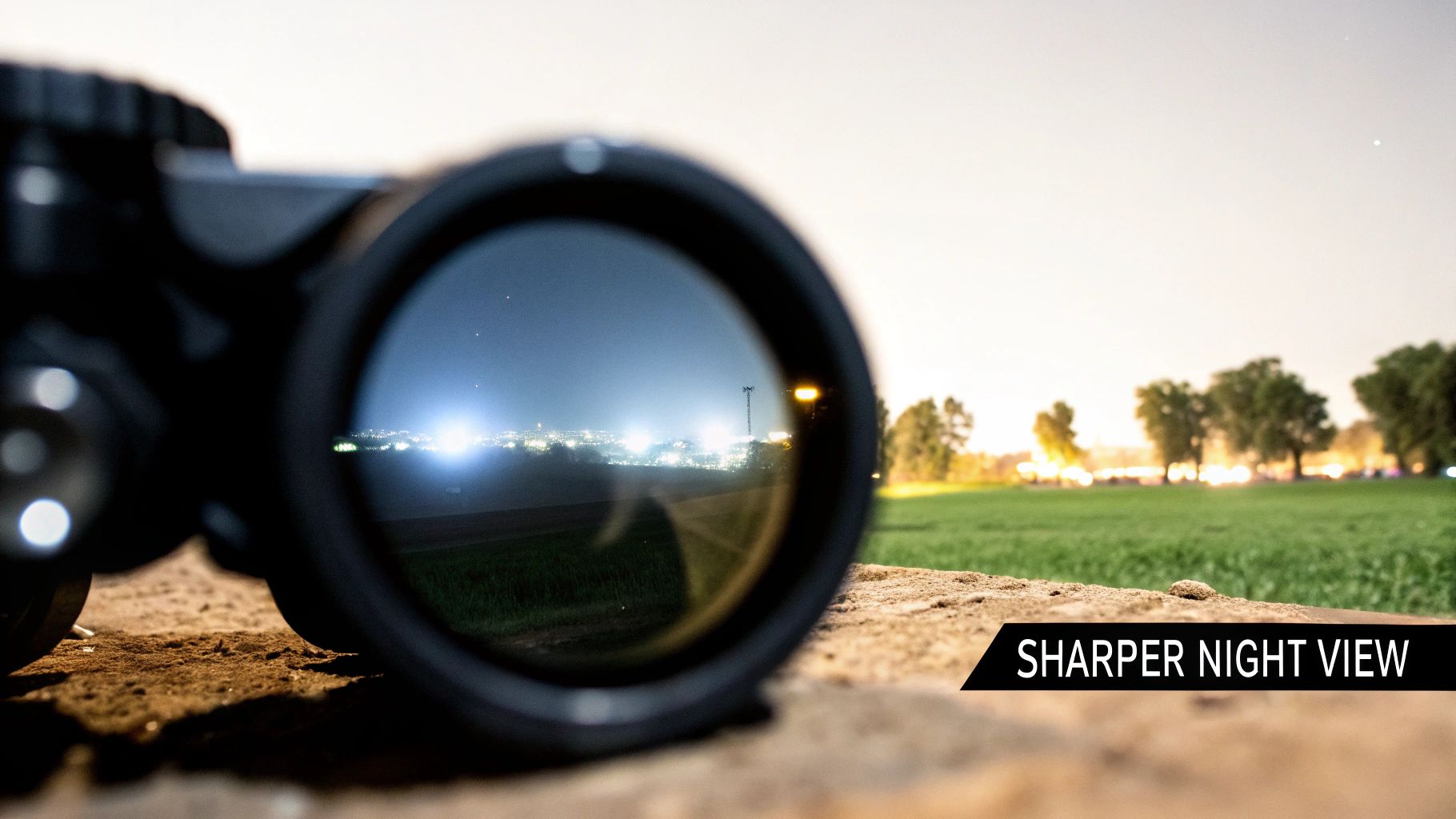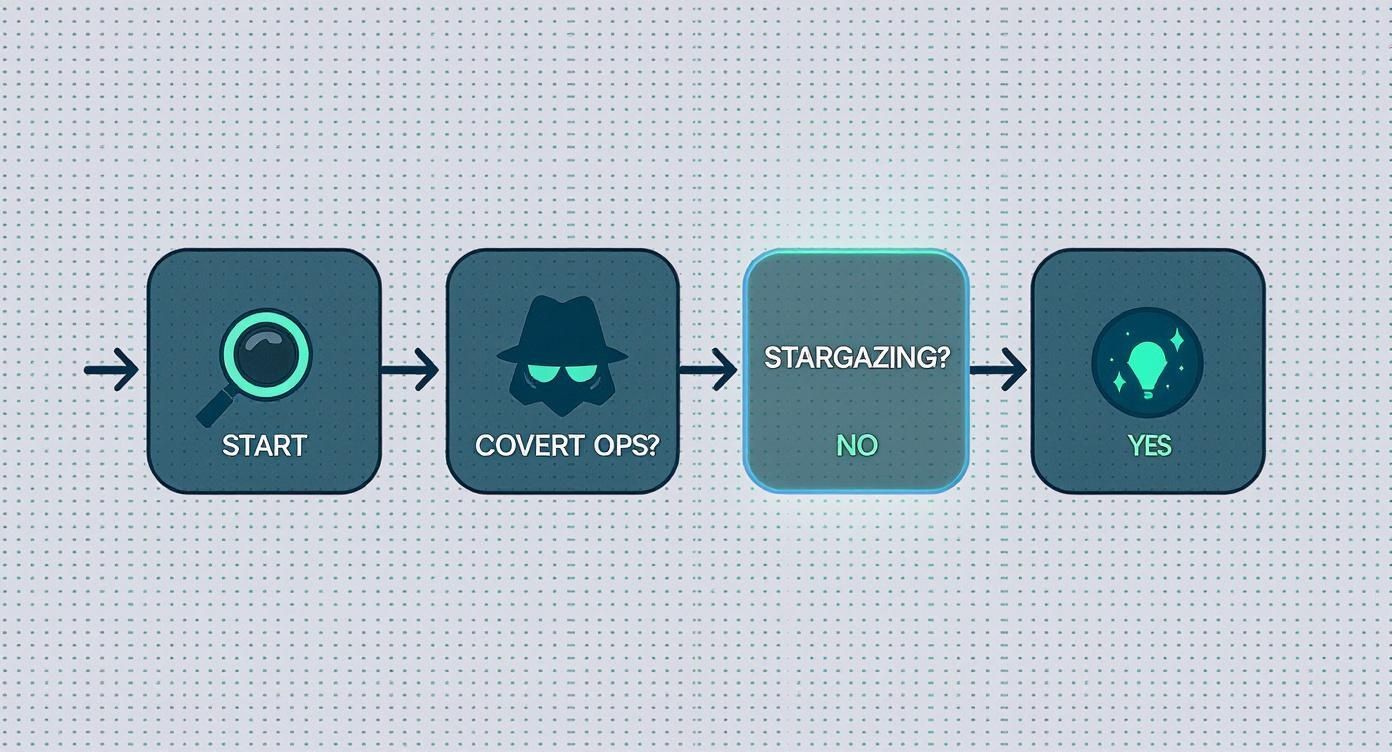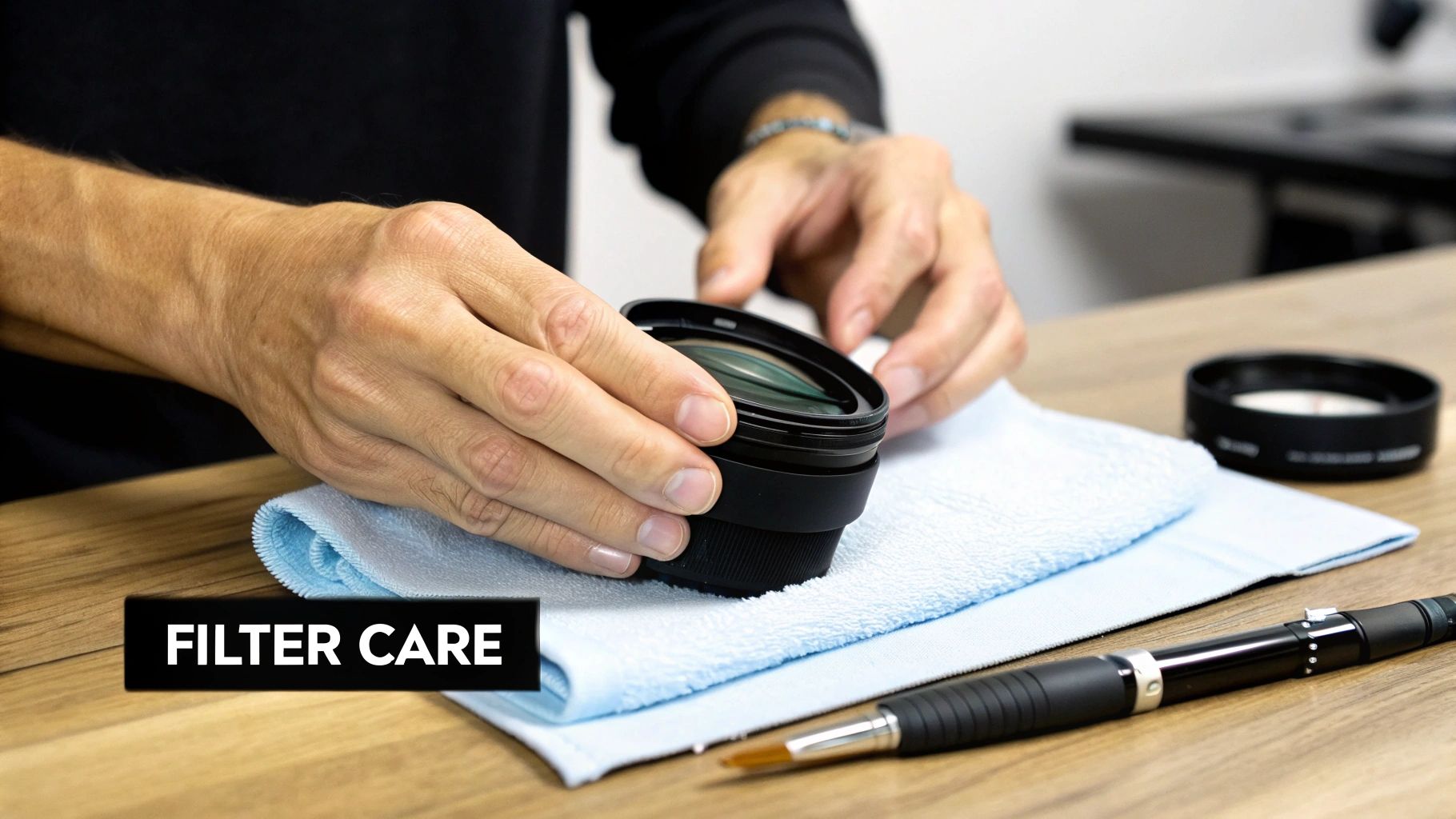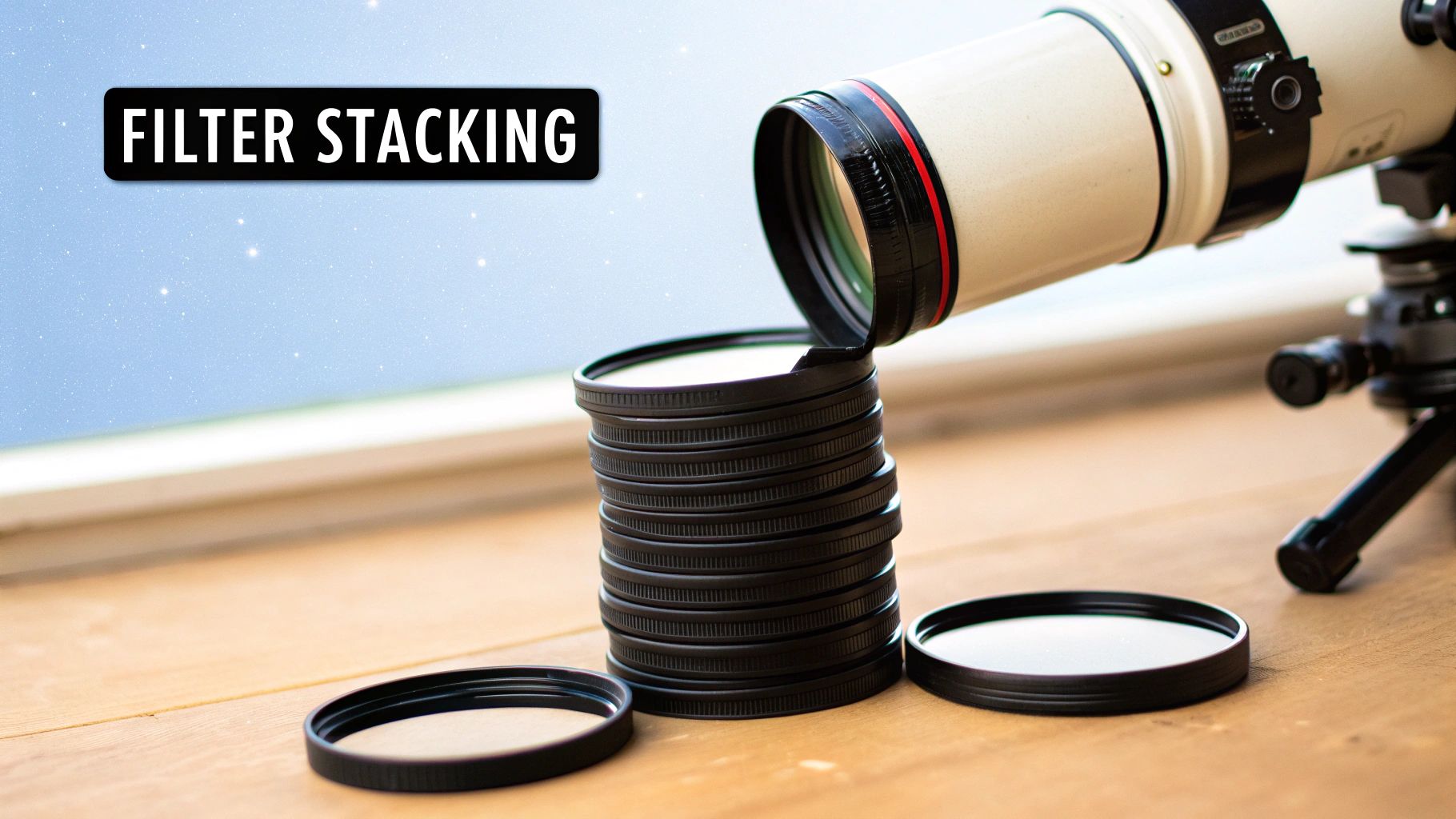A Guide to Night Vision Filters
Night vision filters are specialized accessories that attach to your night vision device, and they’re one of the best upgrades you can make. Their job is to dramatically improve image quality, cut down on eye strain, and even protect the delicate guts of your unit.
Think of a filter like noise-canceling headphones for your eyes. They strip out all the unwanted visual “noise” so you can see with incredible clarity in the dark. By selectively managing which wavelengths of light get through, they sharpen the entire picture.
How Night Vision Filters Sharpen Your View

Picture yourself in a crowded, noisy room trying to listen to one specific conversation. It’s tough, right? All that background chatter makes it nearly impossible to focus. An unfiltered night vision device has the exact same problem, but with light instead of sound. It sucks in all the available ambient light, but a lot of that light is junk.
Glare from a distant streetlight, haze in the air, and general light pollution all act as visual static. This “noise” washes out critical details and kills your image clarity.
This is where a good filter proves its worth. It works by isolating the most useful wavelengths of light and blocking the rest. By essentially cleaning up the light before it hits the image intensifier tube, the filter delivers a much crisper, higher-contrast image. This doesn’t just make it easier to spot what you’re looking for; it also cuts way down on that classic green “sparkle” (scintillation), making long sessions much easier on your eyes.
The Core Benefits of Using a Filter
At its heart, a filter is all about managing light to boost performance. For anyone who relies on night vision, from a law enforcement officer to an avid stargazer, this translates into some very real advantages.
Here’s what you gain:
- Enhanced Contrast and Clarity: Filters make the background darker, which forces your target to pop. This is a game-changer when trying to pick out something in a cluttered or camouflaged environment.
- Reduced Eye Fatigue: By toning down excessive brightness and visual noise, filters create a much more comfortable viewing experience. You can stay behind the scope longer without that tired, gritty feeling in your eyes.
- Intensifier Tube Protection: Some filters are designed to block harmful light, like laser strikes or sudden bright flashes. This can save the most expensive and sensitive part of your device from getting fried. Getting familiar with the specifics of your device, such as the advantages of white phosphor night vision, helps you understand why this protection is so vital.
It’s no surprise that the demand for these accessories is booming. The global night vision filters market was valued at about USD 5.2 billion in 2023 and is expected to climb to nearly USD 9.8 billion by 2032. This growth is fueled by serious users in defense and surveillance as well as a growing number of recreational enthusiasts. You can explore more market insights on dataintelo.com.
Understanding the Different Types of Filters
Not all night vision filters are cut from the same cloth. Each type is really a specialized tool built for a specific job. Think of it like a professional photographer’s camera bag—you’ve got a lens for portraits, another for sweeping landscapes. Picking the right filter starts with knowing what each one is actually designed to do.
At their core, these filters work by playing gatekeeper with the light spectrum. They let certain wavelengths of light pass through while blocking others. This selective filtering is the secret sauce to sharpening your view, whether you’re trying to stay hidden or get a clearer look at the night sky.
Infrared Pass Filters for Covert Operations
When you absolutely cannot be seen, an infrared (IR) pass filter is your best friend. Its whole purpose is to block all visible light, letting only infrared light hit your night vision device’s sensor. Couple this with an IR illuminator, and you become a ghost in the dark.
Picture a security team on patrol. They can light up an entire field with an IR illuminator, but with an IR pass filter, that light is completely invisible to the naked eye. To anyone else, the area is pitch black. This is exactly why these filters are a non-negotiable piece of kit for military and law enforcement—staying undetected is a massive tactical advantage.
Light Pollution Filters for Stargazing
If you’re an astronomer or just love looking at the stars, you know that light pollution is the enemy. That ambient glow from cities can completely wash out faint objects like nebulae and galaxies, turning a stunning celestial canvas into a murky disappointment. A light pollution filter is your shield against this visual noise.
These filters are built to target and block the specific wavelengths of light from common streetlights, like sodium and mercury vapor lamps. By cutting out that artificial skyglow, the filter punches up the contrast, making deep-sky objects pop against the dark background. It’s the single best upgrade for anyone doing serious stargazing from a suburban backyard.
Specialized Color and Bandpass Filters
Moving beyond the common types, you’ll find a whole world of specialized filters built for highly technical and scientific work. These are designed to isolate extremely narrow slices of the light spectrum, which can pull out details that are otherwise invisible. It’s a fascinating field where different materials can be identified just by how they reflect specific kinds of light.
These advanced filters are critical tools in a few key areas:
- Forensics: At a crime scene, an investigator might use a specific color filter to make bodily fluids or chemical traces glow, revealing evidence that was hidden in plain sight.
- Agriculture: Bandpass filters can be used to check on crop health. They highlight tiny changes in how plants reflect light, which can be an early warning sign of stress or disease.
- Search and Rescue: In the field, certain filters can help teams tell the difference between a brightly colored jacket and the surrounding foliage, making it easier to spot a lost hiker.
While you probably won’t need these for a weekend camping trip, they show just how powerful light management can be. To dig deeper into how the underlying devices work, it’s worth understanding the differences between thermal imaging vs digital and analog night vision.
Choosing the Right Filter for Your Mission
When it comes to night vision filters, there’s no single “best” option. It’s all about matching the tool to the task at hand. The filter a pilot needs to clearly read their cockpit instruments is completely different from what a wildlife photographer needs to track an animal in the dark. Your specific goal is what truly dictates the right choice.
Think of your night vision device like a high-performance engine. The filter is the specialized fuel you put in it. You wouldn’t use nitromethane meant for a dragster in a 24-hour endurance race, right? The same logic applies here. Each filter is designed to give you an edge under very specific light conditions.
Aligning Filters with Field Applications
Every environment presents unique challenges. Light, visibility, and the need for stealth can vary wildly from one situation to the next. An officer clearing a building has a set of priorities that are worlds apart from an astronomer trying to get a better look at a distant nebula.
Let’s break down how to pick a filter based on what you’ll be doing.
For tactical operators and law enforcement, the name of the game is stealth and positive target identification. This is where an IR Pass filter becomes indispensable. It cuts out all visible light, letting you pair your device with an IR illuminator without broadcasting your position to everyone around you. To the naked eye, you’re invisible; through your NVD, the scene is lit up like day.
Hunters and wildlife observers have a different set of needs. They often spend hours scanning the terrain, waiting for movement. In this case, a light-suppressing filter or one that reduces eye fatigue is the way to go. These filters dial back the intense green glow, which helps improve contrast and makes it much easier to spot an animal against a busy background. Plus, your eyes will thank you after a long night.
This decision tree gives you a great visual starting point for matching your activity to a filter.

As you can see, the specific demands of your mission—whether it’s total covertness for a tactical user or maximum clarity for a stargazer—point you toward very different filter solutions.
To make things even clearer, here’s a quick-glance table matching some common activities with the best filter for the job.
Filter Recommendations for Common Activities
| Activity | Recommended Filter | Primary Advantage |
|---|---|---|
| Tactical Operations | IR Pass | Complete stealth when using an IR illuminator. |
| Hunting / Wildlife Observation | Light-Suppressing / Amber | Reduces eye strain and improves contrast for spotting. |
| Astronomy | Light-Pollution Filter | Blocks artificial light to reveal faint celestial objects. |
| Aviation (Cockpit) | Minus-Blue Filter | Prevents NVD autogating from dimming the image. |
| General Purpose / Urban | Sacrificial Lens | Protects the objective lens from scratches and impacts. |
This table isn’t exhaustive, of course, but it covers the most common pairings and highlights how a filter’s benefit is directly tied to the user’s objective.
Key Compatibility and Material Considerations
Once you know what type of filter you need, the next step is making sure it will actually work with your specific device. Compatibility isn’t optional, and it really boils down to two things: thread size and material.
- Thread Size: Filters screw directly onto the objective lens of your NVD. You have to match the filter’s thread size (for example, 37mm) to your device’s lens. If the numbers don’t match, it simply won’t fit.
- Lens Material: Most filters are made from either high-quality optical glass or a durable polymer. Glass generally offers the best clarity and scratch resistance, but polymer is lighter and more impact-resistant, making it a solid choice for rough field use.
The demand for this kind of gear is only growing. The global night vision market hit about USD 11.37 billion and is expected to climb to USD 17.72 billion by 2033, a trend pushed by military, law enforcement, and civilian interests like camping and hunting. As more people use NVDs, choosing the right accessories to get the most out of them becomes even more important. You can learn more about night vision market growth at imarcgroup.com.
Pro Tip: For pilots, a “Minus-Blue” filter is absolutely mission-critical. It’s specifically designed to block the blue-green light from modern “glass cockpit” displays. This prevents the NVD’s autogating feature from dimming the image, so pilots can clearly read their instruments while maintaining full situational awareness of the world outside.
Proper Filter Installation and Maintenance

You’ve invested in a quality piece of gear, and like any precision optic, your night vision filter needs a little respect. How you handle and care for it directly impacts its performance and longevity. It all starts with getting the installation right—a simple but critical step.
A proper fit ensures the filter sits perfectly flush against the objective lens, creating a solid seal and perfect optical alignment. Get it wrong, and you could be looking at distorted images or, worse, causing real damage to your expensive night vision device.
Securely Attaching Your Filter
Putting a filter on your NVD isn’t complicated, but a moment of carelessness can lead to two major headaches: cross-threading and over-tightening. Both can wreck the delicate threads on your objective lens or the filter itself, turning a simple accessory swap into a costly repair job.
Follow these steps to get it right every single time:
- Inspect the Threads: First things first, give the threads on both the filter and your device a quick look. Make sure they’re clean and free of any grit or dirt.
- Align Carefully: Gently place the filter onto the lens. Don’t force it; just let it rest squarely on the threads.
- Turn Counter-Clockwise First: This is the pro trick. Before tightening, turn the filter backward (counter-clockwise) just a little bit. You’ll feel a tiny “click” as the threads fall into place. That’s your signal they’re perfectly aligned.
- Tighten Gently: Now, turn the filter clockwise. It should spin on smoothly with almost no effort. The moment you feel it become snug, stop. Hand-tight is all you need.
A common rookie mistake is cranking down on the filter. You’re not trying to weld it on. Over-tightening can bind the filter to the lens or even warp the housing, creating a much bigger problem. The goal is a secure fit, not a permanent one.
Essential Cleaning and Storage Practices
A dirty lens will ruin your view, period. Dust, fingerprints, and moisture can degrade your image quality just as badly as any light pollution can. The special anti-reflective coatings on good night vision filters are tough but not invincible, so you can’t just clean them with anything.
Here’s the right way to maintain your filter:
- DO start by using a soft lens brush or a quick blast of compressed air to get rid of any loose dust or debris. You don’t want to grind that into the coating.
- DO use a dedicated lens pen or a fresh, high-quality microfiber cloth to gently wipe away any smudges.
- DON’T ever use a paper towel, a tissue, or the corner of your t-shirt. These materials feel soft, but they’re abrasive enough to leave fine scratches on the lens coatings.
- DON’T use harsh cleaners like Windex or rubbing alcohol. They can eat away at the protective coatings and ruin the filter.
When you’re not using them, keep your filters tucked away in a padded case. This protects them from getting banged around, covered in dust, or exposed to moisture. And for everyday protection, a simple daylight filter lens cover is a great way to shield your main objective lens from accidental bumps and scratches, keeping your whole setup ready for action.
Advanced Applications and Filter Stacking

Once you get comfortable with the basics, you’ll find that night vision filters unlock some truly fascinating and specialized capabilities. This is where seasoned professionals and dedicated hobbyists start combining filters—a practice we call filter stacking—to zero in on incredibly specific wavelengths of light. It’s all about layering different optical properties to pull off effects that no single filter could manage on its own.
Think of it like mixing paint. You wouldn’t just use blue straight from the tube; you’d add a touch of white or black to get the perfect shade. Filter stacking lets you do the same thing with light, giving you precise, surgical control over what you see in the dark.
The Art of Stacking Filters
Astrophotography is arguably the best showcase for filter stacking. A serious stargazer might layer a light pollution filter with a narrowband one to capture breathtaking images of a distant nebula. The first filter acts like a bouncer, kicking out all the annoying city skyglow. The second one then isolates the very specific light signatures coming from ionized hydrogen or oxygen gas clouds light-years away.
The result is a stunningly high-contrast image, where the deep-sky object pops against a velvety black backdrop. It’s a technique that elevates a standard night vision device into a legitimate tool for exploring the cosmos.
But it’s not just about looking up at the stars. A wildlife biologist, for example, could stack filters to watch nocturnal animals without spooking them.
By pairing a specific IR pass filter with other specialty lenses, scientists can study animal behavior in what, to the animal, is complete darkness. This ensures they’re observing natural activity, not just a reaction to being watched.
Specialized Filters in Research and Security
In highly technical fields like scientific research and security, the focus shifts to single, purpose-built night vision filters. These aren’t the kind of accessories you just add to your cart; they’re engineered for mission-critical tasks where seeing subtle differences in light can mean everything.
- Wildlife Biology: Researchers often rely on narrow-bandpass IR filters to study nocturnal species. This allows them to flood an area with powerful IR light for crystal-clear observation without producing a single photon of light the animals can actually see.
- Forensic Science: On a crime scene, specialized filters can be a detective’s best friend. Certain filters will cause trace evidence like chemicals or bodily fluids to fluoresce under specific lighting, making invisible clues suddenly jump out.
- Industrial Inspection: In manufacturing and maintenance, some filters can detect tiny temperature shifts or material stresses that only appear in the near-infrared spectrum. This can help technicians spot a potential equipment failure long before it becomes a catastrophe.
Regulatory Controls on High-Performance Filters
It’s important to remember that the most advanced night vision gear is often subject to strict government oversight. Export controls play a huge role in the global market for these devices and their filters. Regulations like the U.S. International Traffic in Arms Regulations (ITAR) put tight restrictions on the sale and shipment of sensitive, military-grade equipment. These rules are designed to keep top-tier systems out of the wrong hands. You can discover more insights about these global market dynamics on mordorintelligence.com.
Frequently Asked Questions
When you start digging into night vision filters, a few questions always seem to pop up. Getting straight answers is the best way to pick the right filter and actually get the performance you’re paying for. Here, we’ll tackle some of the most common queries I hear.
We’ll cover everything from whether one filter can fit all your devices to how they might affect your battery on a long night. Think of this as the quick-and-dirty guide to getting it right.
Do Night Vision Filters Work on All Devices?
That’s a common hope, but unfortunately, no. Compatibility really boils down to one thing: the thread size on the objective lens of your night vision device. For a filter to attach correctly, its thread diameter (like 37mm, for example) has to match your monocular or goggle’s threads perfectly.
While a lot of gear from major brands uses standard sizing, there’s no universal standard across the board. The golden rule is to always check the specs of your device before you buy a filter. It saves a lot of headaches.
How Do Filters Affect Battery Life?
For the most part, you won’t even notice a difference. Night vision filters are passive accessories—they don’t draw any power themselves. They’re just a piece of coated glass or polymer that sits in front of your lens, doing its job without needing a single electron.
Now, if you’re using a particularly dark filter, you might argue that it makes the image intensifier tube work a tiny bit harder because less light is getting through. But in the real world, this effect is so small it’s practically unmeasurable. Your batteries will last just as long as they always do.
What Is the Difference Between Glass and Polymer Filters?
This one comes down to a classic trade-off: image quality versus toughness.
- Glass Filters: These are the champs of optical clarity. They’ll give you the sharpest, most pristine image your device is capable of producing. They’re also much more resistant to getting scratched up during cleaning.
- Polymer Filters: Think of these as the rugged workhorses. They’re significantly lighter and can take a beating, which is a huge plus if you’re worried about drops and impacts in the field.
At the end of the day, your mission dictates the material. If you need flawless image quality for something like astrophotography, glass is the only way to go. But for hard-use tactical or hunting applications where your gear might get knocked around, the durability of polymer is probably the smarter bet.
Ready to upgrade your view and protect your gear? The team at Superior Tactical LLC has spent over a decade helping people get the right night vision equipment for the job. We’ve curated a collection of top-tier optics and accessories, and we back it all up with real-world expertise. Find your perfect night vision solution at superiortac.com.
